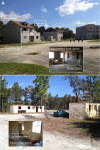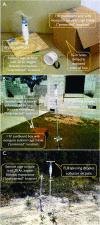Aerial ULV control of Aedes aegypti with naled (Dibrom) inside simulated rural village and urban cryptic habitats
- PMID: 29352307
- PMCID: PMC5774805
- DOI: 10.1371/journal.pone.0191555
Aerial ULV control of Aedes aegypti with naled (Dibrom) inside simulated rural village and urban cryptic habitats
Abstract
We conducted aerial fixed wing ultra low volume (ULV) spray trials with naled to investigate penetration of exposed and simulated cryptic habitat within opened buildings, partially sealed buildings, and outdoor locations targeting sentinel adult Aedes aegypti mosquitoes in north central Florida. Mortality was observed in open and closed buildings and outdoors, even in mosquitoes placed in cryptic habitats. Observations on the impact of building type, mosquito exposure method such as placement in cryptic habitat, and spray nozzle size on mosquito mortality are described and analyzed.
Conflict of interest statement
Figures





Similar articles
-
Managing Aedes aegypti populations in the first Zika transmission zones in the continental United States.Acta Trop. 2018 Nov;187:108-118. doi: 10.1016/j.actatropica.2018.07.031. Epub 2018 Jul 31. Acta Trop. 2018. PMID: 30075097
-
Rapid Screening of Aedes aegypti Mosquitoes for Susceptibility to Insecticides as Part of Zika Emergency Response, Puerto Rico.Emerg Infect Dis. 2019 Oct;25(10):1959-1961. doi: 10.3201/eid2510.181847. Emerg Infect Dis. 2019. PMID: 31538919 Free PMC article.
-
Evaluation of equipment modifications and dosage rates of ground ULV applications of naled against Aedes taeniorhynchus in a Florida citrus grove.J Am Mosq Control Assoc. 1988 Sep;4(3):345-50. J Am Mosq Control Assoc. 1988. PMID: 3251479
-
Essential Facts About Mosquito Control and Zika Virus.Am J Med. 2016 Nov;129(11):1149-1152. doi: 10.1016/j.amjmed.2016.07.021. Epub 2016 Aug 20. Am J Med. 2016. PMID: 27555094 Review.
-
Public Health Interventions for Aedes Control in the Time of Zikavirus- A Meta-Review on Effectiveness of Vector Control Strategies.PLoS Negl Trop Dis. 2016 Dec 7;10(12):e0005176. doi: 10.1371/journal.pntd.0005176. eCollection 2016 Dec. PLoS Negl Trop Dis. 2016. PMID: 27926934 Free PMC article. Review.
Cited by
-
A Review of the Control of Aedes aegypti (Diptera: Culicidae) in the Continental United States.J Med Entomol. 2021 Jan 12;58(1):10-25. doi: 10.1093/jme/tjaa157. J Med Entomol. 2021. PMID: 32829398 Free PMC article. Review.
-
Field Efficacy Trials of Aerial Ultra-Low-Volume Application of Insecticides Against Caged Aedes aegypti in Mexico.J Am Mosq Control Assoc. 2019 Jun;35(2):140-146. doi: 10.2987/18-6796.1. J Am Mosq Control Assoc. 2019. PMID: 31442128 Free PMC article.
-
Entomological Efficacy of Aerial Ultra-Low Volume Insecticide Applications Against Aedes aegypti (Diptera: Culicidae) in Mexico.J Med Entomol. 2019 Sep 3;56(5):1331-1337. doi: 10.1093/jme/tjz066. J Med Entomol. 2019. PMID: 31120502 Free PMC article.
-
Transforming entomology to adapt to global concerns: 2021 student debates.J Insect Sci. 2023 Jul 1;23(4):11. doi: 10.1093/jisesa/iead064. J Insect Sci. 2023. PMID: 37527466 Free PMC article.
-
A Cross-Sectional Household Survey in the US Virgin Islands (2019) Reveals Cisterns as Challenging Peridomestic Aedes aegypti Habitats.J Am Mosq Control Assoc. 2022 Jun 1;38(2):113-117. doi: 10.2987/21-7022. J Am Mosq Control Assoc. 2022. PMID: 35588174 Free PMC article.
References
-
- Likos A, Griffin I, Bingham AM, Stanek D, Fischer M, White S, et al. Local mosquito-borne transmission of Zika virus—Miami-Dade and Broward Counties, Florida, June–August 2016. MMWR Morb Mortal Wkly Rep [Internet]. 2016;65:10321038. Available from: https://www.cdc.gov/mmwr/volumes/65/wr/pdfs/mm6538e1.pdf 10.15585/mmwr.mm6538e1 - DOI - PubMed
-
- Reiter P, Gubler DJ, Clark GG. Lack of efficacy of vehicle-dispensed ultra-low volume aerosols for the control of Aedes aegypti in urban San Juan, Puerto Rico. Arbovirus research in Australia Proceedings from the 5th Symposium, August 28-September 1, 1989, Brisbane, Australia. 1989;192.
-
- Gratz NG. Emergency control of Aedes aegypti as a disease vector in urban areas. J Am Mosq Control Assoc. 1991;7(3):353–65. - PubMed
-
- Hudson JE. The 1982 emergency ultralow volume spray campaign against Aedes aegypti adults in Paramaribo, Suriname. Bull Pan Am Health Organ [Internet]. 1986;20(3):294–303. Available from: https://www.ncbi.nlm.nih.gov/pubmed/3801746 - PubMed
Publication types
MeSH terms
Substances
LinkOut - more resources
Full Text Sources
Other Literature Sources

